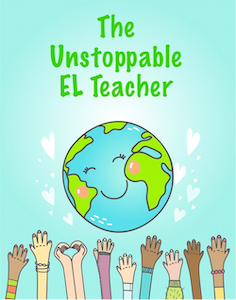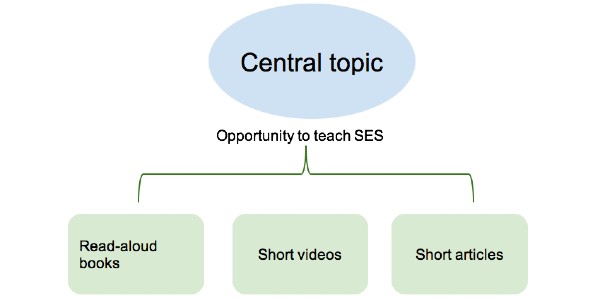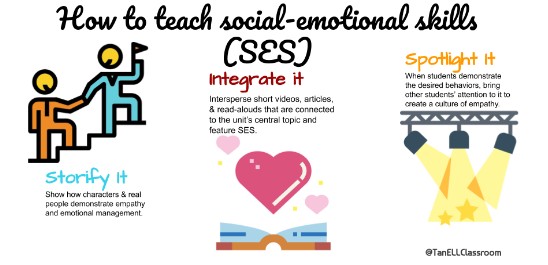How to Integrate SEL into Our EL Classrooms
A MiddleWeb Blog

This week, I’ll share my thoughts on how we can structure social-emotional learning (SEL) to best serve and support our English Learners.
This topic was suggested by Dr. Brandon Beck, a National Board Certified Teacher who is a professor and consultant in Tarrytown, New York. You can follow Brandon on Twitter where he shares many resources as well as regular illustrated updates about his school’s “comfort dog” Peaches.
Storify Social-Emotional Learning
When we think about young learners, we think of elementary school children gathered on the carpet listening to a story being read aloud. But just like elementary kids, middle schoolers and children of all ages (adults included!) love to hear stories.
They not only entertain us, they can also be powerful tools in teaching valuable social-emotional school skills, such as empathy, emotion management, and impulse control.
But social-emotional education does not mean imposing a specific program on students or purchasing a curriculum. Just like with effective vocabulary and grammar instruction, social-emotional learning is best done in context (Beck, McKeown, & Kucan, 2008; Anderson, 2005) through stories connected to the content we are teaching.
For example, in a 10th grade English unit on heroes, we watched videos from CNN Heroes, visited a local social enterprise, and read The Hunger Games. Each text gave us opportunities to identify essential social-emotional skills worth developing. Below are the social-emotional skills we addressed in each of these texts:
- CNN Heroes: empathy
- Interview at a social enterprise: problem-solving
- The Hunger Games: emotional management
I’m sure you are already imagining similar connections in the middle grades curriculum.
A framework for content-integrated instruction
Instead of having a series of lessons about these skills in our advisory class, we seamlessly integrated them with the content. Here’s a framework for content-integrated instruction of social-emotional skills:
- Start with the content.
- Identify the social-emotional skills derived from the content.
- Design content-based learning experiences that highlight the social-emotional skills.
- Ask students where they can apply these skills in their own lives.
Integrating social-emotional skills for Emerging ELs
For younger ELs (and even middle school ELs, as Valentina described here), teachers can choose to integrate a read-aloud book, a short video, or a short article into the unit to teach both content and social-emotional skills. Integration doesn’t make the older ELs feel like they’re being babied as each of the texts is connected to the unit in a meaningful way.
During a 5th grade unit about access to resources, our central text was the novel A Long Walk to Water. We read one topic per day from If The World Were a Village before going into the novel study. This read-aloud expanded their understanding of the disparity of the distribution of resources and helped them develop a greater appreciation for the bounty that my affluent students experience.
Simple spotlighting
Choosing the right classroom materials is essential to developing social-emotional skills, but it’s not the only thing you can do. One of the best ways to teach emotional skills is by providing positive feedback on the behavior of your students.
So my final tip for teaching social-emotional skills to all students is to spotlight when you see behaviors that show empathy, emotional management, and non-violent communication (Kamenetz, Turner, & Weiner, 2019). As with the previous strategies, this technique doesn’t just benefit ELs, it benefits all students, especially those who have mood or behavior difficulties – such as ADHD, anxiety, depression, or oppositional defiant disorder – that make it difficult to identify and manage their emotions.
This strategy requires no planning and curriculum integration. It just requires having a heightened awareness of the desired social-emotional skills. Consider praising students when:
- They choose to sit away from their friends who might distract them.
- They use “I feel ___, when you ___” statements during a conflict.
- They take deep breaths to calm themselves when they’re upset.
- They consider the perspective of others in a conflict.
- They allow others to speak during a dispute.
We often focus too much on when students do not behave in desired ways. This is true especially when they are twice-exceptional and may be struggling with two issues at once, like the EL who struggles with ADHD. Instead, invest more energy and time in spotlighting moments when they demonstrate the desired skills and celebrate them.
In Closing
Whatever method you use, ELs are capable, and they should be taught to develop social-emotional skills. We want to nurture these soft skills because they lead to greater academic success (Durlak et al., 2011) and are key indicators of later life success (Jones, Greenberg, & Crowley, 2015).
We want our ELs to leave our classes and schools not only with greater language command but with more emotional control and awareness of others’ perspectives. If ELs leave our schools with improved English skills but do not come to the aid of a person who slipped and fell, then we have only taught half of what we needed to.
References
Anderson, J. (2005). Mechanically inclined: Building grammar, usage, and style into writer’s workshop. Portland, ME: Stenhouse.
Beck, I.L., McKeown, M.G., & Kucan, L. (2008). Bringing words to life: Robust vocabulary instruction. New York: The Guilford Press.
Durlak, J. A., Weissberg, R. P., Dymnicki, A. B., Taylor, R. D., & Schellinger, K. B. (2011). The impact of enhancing students’ social and emotional learning: A meta-analysis of school-based universal interventions. Child Development, 82(1): 405–432.
Jones, D. E., Greenberg, M., & Crowley, M. (2015). Early social-emotional functioning and public health: The relationship between kindergarten social competence and future wellness. American Journal of Public Health, 105(11): 2283–2290.
Kamenetz, A., Turner, C., & Weiner, C. (2019, May 13). Kindness Can Be Taught. Here’s How. Parenting: Raising Awesome Kids. Podcast retrieved from https://www.npr.org/podcasts/510344/raising-awesome-kids





































